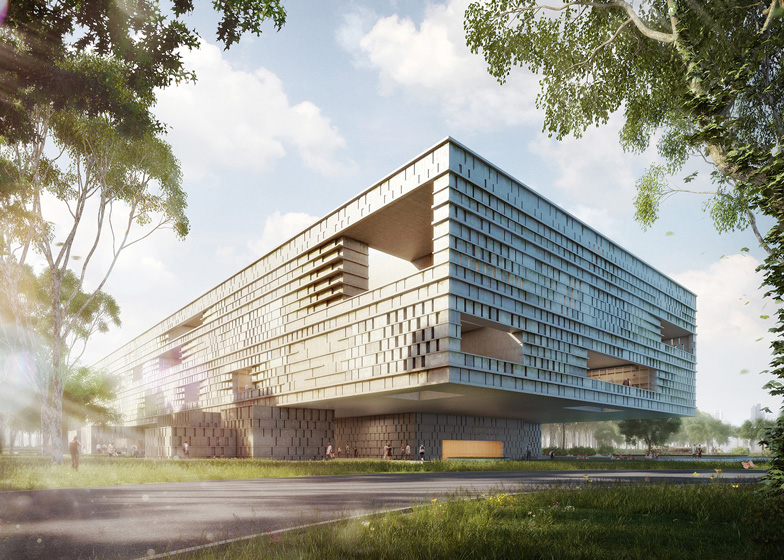News: Swiss firm Harry Gugger Studio and Boston office over,under have teamed up to design Central America's largest museum of Mayan history and culture for a site in Guatemala City.
Planned for the northern edge of L'Aurora Park, the Museo Maya de América will house a vast collection of historical artefacts from the Mayan regions of southern Mexico and northern Central America, within an all-new structure that draws on the architecture of traditional Mayan temples.
The stone-clad exterior of the building will be punctured by a series of openings that draw light and ventilation through to a succession of galleries and corridors, which will be laid out in a chequerboard-like pattern.
"At first glance, the building appears to be a contemporary expression of Maya architectural elements," said Harry Gugger. "It forms a monolithic box perched atop blocks of stone, as if floating above the ground."
"On closer inspection, a pattern of staggered stone screens is punctuated by over-scaled loggias that draw light into the building and offer glimpses inside," he added.
The building will centre around a lofty courtyard modelled on a natural sinkhole, called a cenote, which will be surrounded by staircases.
"The central court evokes the cenote, a type of natural sinkhole characteristic of the Yucatan and held sacred by the Maya," said over,under principal Roberto de Oliveira Castro. "Open to the sky and lushly planted, the eight-storey cenote functions as the heart of the museum, its displays, and its activities."
The ground floor will be opened out to its surroundings to encourage the public to explore the building, while the roof will accommodate gardens, outdoor galleries, viewing terraces and a restaurant.
Construction is expected to start in 2015, in collaboration with local studio Seis Arquitectos, and the building is scheduled to open in 2017.
Here's a project description from Harry Gugger Studio:
Museo Maya de América, Guatemala City
La Fundación Museo Maya de América unveils the design of Central America's largest museum of Maya artefacts and culture
The Museo Maya de América, to be located in Guatemala City, will become a leading venue for the public to view objects, artefacts, artworks, textiles, and information on the history and culture of the Maya civilisation. The institution is among the most ambitious cultural projects in the region, containing approximately 60,000 square metres of program (more than 600,000 square feet) with a construction budget of US$60 million.
"With an enormous sense of optimism and a vision for the future, we aim to create a museum that celebrates Maya culture and carefully explains it," stated Fernando Paiz, president of the sponsoring organisation Fundación Museo Maya de América. "We want the world to understand the sophistication and richness of this civilisation in Guatemala and beyond."
Sited at a prominent location at the northern edge of L'Aurora Park, the museum will be immediately visible when exiting Guatemala City's international airport. It will become the capstone to a series of museums, including the Children's Museum and the Museum of Contemporary Art. This cultural nexus-located in what is expected to become the largest recreational open space in the city—will provide a new destination for tourists and residents alike.
The Museo Maya de América's striking design will contribute to that effort, drawing inspiration from the language of traditional Maya temple architecture without directly replicating it. "At first glance, the building appears to be a contemporary expression of Maya architectural elements," stated Harry Gugger, principal of Harry Gugger Studio. "It forms a monolithic box perched atop blocks of stone, as if floating above the ground. On closer inspection, a pattern of staggered stone screens is punctuated by over-scaled loggias that draw light into the building and offer glimpses inside." The building presents this large, abstract form to the surrounding city.
Organised for maximum public interaction with the site, the ground is given almost entirely to open space. The galleries reside within the floating box, connected to the lower levels by stairs that climb their way around a central courtyard.
"The central court evokes the cenote, a type of natural sinkhole characteristic of the Yucatan and held sacred by the Maya," stated Roberto de Oliveira Castro, principal of over,under. "Open to the sky and lushly planted, the eight-story cenote functions as the heart of the museum, its displays, and its activities." It forms an orientation point within the museum and extends down to the parking levels below ground, providing an interesting route into the museum and a special place to display underworld-related artefacts.
The building takes advantage of Guatemala's temperate climate by naturally ventilating all but a small number of spaces that require artificial conditioning. The exhibition floors are organised in a chequerboard of galleries and circulation areas. The walls of the circulation spaces are lined with glass cases to place the collection of artefacts - normally in storage - on display.
The landscaped roof is returned to the general public as an accessible civic space, containing a restaurant, outdoor galleries, gardens, and viewing terraces. The large surface of the roof will be used to collect rainwater and filter it through the cenote in a manner recalling traditional Maya practices of channeling water.
The design of the Museo Maya de América has been developed by Harry Gugger Studio of Basel and over,under of Boston. Seis Arquitectos of Guatemala City will serve as the architect of record.
Conceptual design work has been completed, and a fundraising campaign has commenced. Construction is expected to start in 2015 with completion by 2017.

